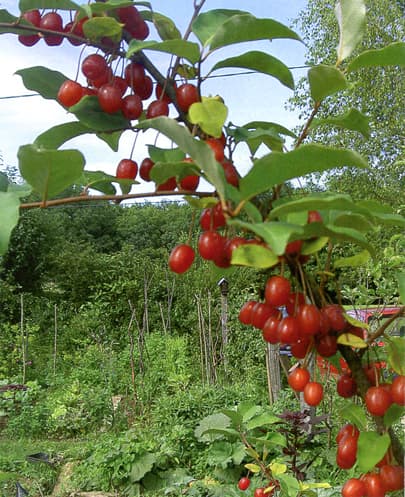Boxthorn is known as a "red diamond", and considered one of the most valuable herbs in the world. It is also known after the names of "happiness berries", "longevity fruits".
The plant is valued for its berries rich with antioxidants, vitamins, macro and trace elements. Boxthorn berries contain twice more antioxidants than green tea, and 15 times more iron than spinach.
Dried sourish berries are used for food: cocktails, salads, breakfast cereals. Ornamental perennial plants growing to 1.5 m. Potted plant should be trimmed to provide it the desired shape and height.
Potted plants are transferred to the room in winter, with the temperature from -1 to +2°C. Grow best in medium fertile loam or loam soil. Resistant to drought, not tolerant to wet roots.
10 seeds will produce about 7 plants.

Goji berry (Gumi, boxthorns) cannot be called a new crop, but not every gardener has it on the site.
This plant, outlandish for many, is difficult to find in stores and markets, especially in the northern regions. However, the demand for unusual plants that produce tasty and healthy fruits is gradually increasing. Goji berry belongs to such plants. If you search carefully, you can find 2-3 dozen gumi seedlings in nurseries engaged in the production of planting material.
And, having already bought a seedling and grown a strong plant, you can learn how to propagate it yourself.
Goji berry is a typical representative of the family and a close relative of sea buckthorn. Fortunately, unlike sea buckthorn, gumi has thorns only in the lower part of the shoots, besides, they are not as sharp as those of sea buckthorn, and their number is several times less. However, when collecting fruits, be careful - you can still get hurt by them. The presence of a small number of thorns and a rather low winter hardiness, due to which, in Estonian conditions, the tips of the shoots can freeze slightly - these are the only "minuses" of the Goji berry.
Otherwise, gumi has only “pluses”. So, for example, it is very easy and quick to harvest, since the shoots in the upper part are completely devoid of thorns, and the fruits themselves are attached to long stalks.
Everyone will like the taste of fruits: they are devoid of bitterness and astringency, have tender juicy pulp and a small elongated bone resembling almonds.
Wolfberry, like sea buckthorn, has nodules on the roots, in which nitrogen-fixing bacteria “live”. This symbiosis also makes it possible to enrich the soil with nitrogen.
According to the structure of the bush, gumi also has much in common with sea buckthorn, however, in the Baltic conditions, gumi is unlikely to exceed 2 m, while sea buckthorn here grows about 2 times higher.
Depending on the habitat, the gumi plant looks like either a small bush or a miniature tree. Gumi shoots are quite powerful, often the shrub begins to thicken already at a young age, so it needs sanitary pruning.
A typical sign of gumi is small bright dots on annual growths and darker ones on perennial growths. The leaves are also interesting in gumi: large, elongated, dense to the touch, glossy on the upper side and silvery on the lower side.
Wolfberry is a self-pollinating plant, but yields will be much higher if you plant several plants on the site. You can also notice that on most plants heterosexual flowers bloom; one may be predominantly female, the other only male. This phenomenon is common, especially in seed-derived plants, and the traits of the parents are lost.
Boxthorns shrub will undoubtedly become a decoration of your site. The plant wakes up quite early, usually by the beginning of May you can see the first leaves, and in early May the bush is already fully dressed in a bright green outfit. It is also quite decorative when slightly elongated creamy-white flowers appear with a pleasant aroma that attracts many bees. Approximately 2 months will pass, and rapidly turning pink "barrels" of gumi fruits will appear in place of the flowers.
There are few fruits on young plants, but over the years, yields increase, and the fruits can be used not only fresh, but also for processing.
However, more often they are used fresh: perhaps because their taste is special, unlike any other.
Eng.: Boxthorns, Goji Berry, Wolfberry. Bot. syn.: Boberella halimifolia (Mill.) E.H.L.Krause, Jasminoides flaccidum Moench, Lycium halimifolium Mill., Lycium lanceolatum Veill., Lycium turbinatum Veill., Lycium vulgare Dunal, Teremis elliptica Raf.













